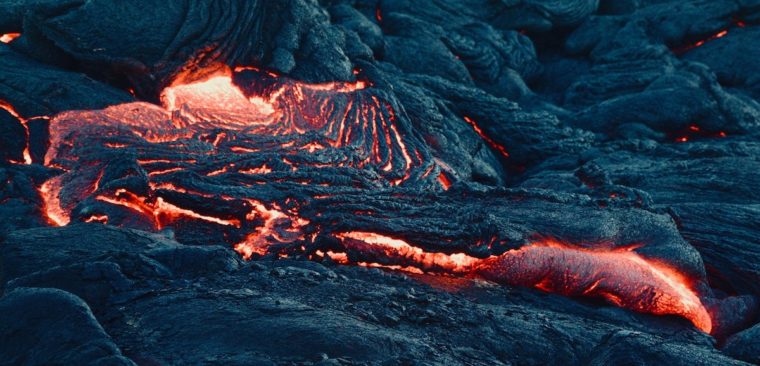Volcanoes! The word itself conjures images of tumbling, racing lava and massive clouds of ash. Volcanoes result when underground molten rock (magma), bits of solid rock, and steam break through the earth’s surface. If this matter and energy builds up pressure before suddenly breaking through, the eruption can be explosive, and possibly deadly. However, the more we study volcanoes, the better we are at predicting and preparing for volcanic activity. We find numerous notable volcanic eruptions in the historical record. One of the most famous is Mt. Vesuvius, which erupted in 79 A.D., expelling 1.5 million tons of rock and ash into the air every second and completely burying nearby towns. The ash bodies recovered a thousand years later were a haunting record of the complete and powerful destruction. With each episode of epic volcanic activity, we learn a little bit more about how the earth is shaped and about how to be safe in an active volcanic environment. Here are 5 notable events from the last 200 years:
On April 10, 1815, Mount Tambora erupted in Indonesia, sending 12 cubic miles of rock and ash into the air and over the land, taking the lives of 10,000 villagers instantly. The following year became known as “the year with no summer” as the ash traveled across the globe, affecting far-flung regions. In Minnesota that year, there was snow in July! All over the world the ash-darkened skies caused low sunlight levels, which led to low crop yields and famine.
Almost a hundred years later, on May 8, 1902, Mount Pelée erupted on the island of Martinique in the West Indies. After a month of earthquakes and small eruptions that drove a host of venomous snakes and centipedes into nearby towns, a massive blast of hot gases and rock (over 500°F) wiped out the surrounding town, even burning up ships in the harbor. The single survivor was a murderer serving his sentence in a concrete jail cell, which ultimately saved his life. His notoriety led to a side show stint in the Ringling Bros. circus!
This volcano was spectacular but not deadly: On February 20, 1943, a farmer in west-central Mexico was clearing his corn field when he stumbled across a small hill that looked like it had cracked open. As he watched, the earth rumbled and the hill grew to tower over him. Over the next 24 hours, the tower threw ash and molten rock into the air and grew 20 stories high. The new volcano grew slowly but steadily, burying the farmer’s corn field in ash and lava, which is magma that has erupted to the surface. Over four months, lava flowed slowly from the growing cone, creeping toward the town of San Juan. All the inhabitants safely evacuated the town, which was eventually blanketed by lava and covered by ash layers, up to 50 feet thick in some places. After ten years, the volcano quieted and has been inactive ever since.
On the flip side, this deadly volcano never actually erupted: In the west African nation of Cameroon, Lake Nyos sits in a caldera, which is a collapsed mouth of a volcano. As carbon dioxide bubbled out of the volcano into the lake, the deeper waters became saturated with the gas. On the evening of August 26, 1986, the ground beneath the lake rumbled, suddenly overturning the lake water and releasing a massive amount of carbon dioxide into the air. The dense gas sank to the lake surface and formed a river of dense gas flowing down the mountain. As it flowed through the villages at the base of the mountain, the gas suffocated livestock, birds, and people. 1700 villagers lost their lives. To prevent another disaster, pumps were installed in the lake to draw up the deepest water and blast it into the air, dispersing the dissolved carbon dioxide into the atmosphere and preventing it from accumulating deep in the lake.
Closer to home, on May 18, 1980, Mount St. Helens in Washington erupted, beginning with a landslide of mud and rock that would have filled a million Olympic-sized swimming pools, and continuing with eruptions that lasted 9 hours. Even though volcanologists had warned of possible explosive eruptions, not everyone evacuated far enough from the mountain. 57 people died, and nearly half of those bodies were buried in ash and never recovered. Thousands of animals died and 10 million trees were destroyed. After two days, volcanic activity decreased, and other than occasional small earthquakes, the volcano remains quiet.
Along with Mount St. Helens, The United States has over 160 potentially active volcanoes. Most of these are in Alaska and along the west coast and are part of the “Ring of Fire”, which is a circle of volcanoes that border the Pacific Ocean. Yellowstone and Hawaiian volcanoes form due to hot spots within the mantle of the earth. Hawaii’s Mount Kilauea has been erupting on and off for nearly 40 years, and in the summer of 2018, its eruptions sent lava across 12.5 square miles and destroyed 700 homes. The lava flow was slow enough for all residents to evacuate, and local businesses offered tours to see creeping lava by land, air, and sea. Yellowstone National Park in Wyoming sits in a giant caldera. As molten rock, liquids, and gases expand and contract just below the surface, the entire park “breathes”, bulging up several inches and descending back down from year to year. In some areas of the park, this geologic activity breaks through the surface in the form of geysers and hot springs, which are popular tourist attractions.
Despite their formidable destructive power, volcanoes are a vital part of the global ecosystem. As lava cools, it forms new land, which plants, animals, and people inhabit. Ash forms nutrient-rich soils that hold water well. Volcanic rock (ex. granite and gabbro) is used in construction, and mineral deposits (ex. aluminum and nickel) are used in manufacturing. Volcanology is a growing and exciting field. As we continue to study volcanoes, they will remain one of nature’s most spectacular phenomena, but become much less detrimental to human life.
Explore volcanoes:
- Look up https://www.usgs.gov/natural-hazards/volcano-hazards/field-guides to see the best places to visit!
- Build your own volcano model, using paper maché or dough. With an adult’s help, create “lava” in two different ways: (1) Put about a ¼ cup of baking soda into the mouth of your volcano, and then pour in a ½ cup of white vinegar mixed with red food coloring. (2) Pour in a ½ cup of warm water mixed with some dish soap, and then add a piece of dry ice.
- And don’t forget this classic game: Yell “The floor is lava!” and count down from five. By the time you reach zero, everyone else must be off the floor. Have a magma-nificent time!


